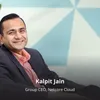Edtech startup Clever Harvey is developing products to help students build their career
In this week’s Product Roadmap, we feature edtech startup Clever Harvey that is working to bridge the gap for students between academics and real-world jobs.
When Sriram Subramanian started with Madhu Agarwal, they had one objective in mind—to solve the gap between academics and the workplace.
While classroom learning is divided into subjects like English, Math, Physics, History, and others, the actual workplace operates on the principles of understanding technology, people, and money.
“We wanted to bridge this gap so that students don’t graduate into the real world without a compass for where they’re going. We began with a pilot of three programs of 10 hours each, where students could learn about three fields--entrepreneurship, marketing, and technology. We launched the pilot programs in April 2020, and in the first three months, we had enrolled 1,200 students,” says Sriram.
From then to now, the edtech startup has grown to offer programs like Junior MBA--Strategy, Technology and Marketing.

Madhu Agarwal, Co-founder, Clever Harvey
Understanding the market
After launching the first three programs, the team analysed the data and found that 50 percent of students and parents opted for all three programs. This was surprising as it did not expect students to be interested in such diverse fields.
The team realised that parents were anxious about their children’s career choices and were seeking guidance from friends and family. They know that there are new careers available today for which they are not fully equipped to guide their children. Parents also wanted their children to have first-hand job experience in the form of internships, but these opportunities aren’t easily accessible.
“After thorough market research, we thought of different ways to make first-hand experiences of the industry more accessible. One of the biggest challenges is the age group of the students we cater to, primarily students from classes 8-12. Most companies are not willing to provide internships for them as they do not have the time to mentor such young students,” says Sriram.
He explains, even students who can get access to such opportunities are often just asked to ‘observe and learn’ or engage in basic tasks such as printing and coordination, which defeats the purpose of trying to get first-hand exposure.
Therefore, the team set its mind to face the challenge by making the internship experience scalable and relieving this supply constraint.
“It took us some time to figure out how we could give students the sense of working on real company problems while not intruding on the time of industry experts. We arrived at a hybrid solution where we partner with companies to set a case study and a challenge for students to solve. Our faculty instructs the students in a structured curriculum to help them learn the key concepts in that field and apply these concepts to solve the challenge set by the industry partner,” says Sriram.
Senior executives at companies deliver first-hand information on their brand and the key principles in the field, but the faculty does all the heavy lifting of teaching students the details of the concept and giving them feedback on their projects.
Building the product
Clever Harvey came up with its first set of industry partnered programs to help teenagers ‘test-drive’ their careers in April 2021.
The programs, with a NPS of 75 percent+, were in high demand and parents and students were asking for options that went beyond the three choices it offered then--entrepreneurship, marketing, and technology.
“This convinced us that we had hit upon a sweet spot to bridge the gap between academics, the real world, and the parent's desire to give their teenagers more clarity on their career through industry exposure. Here, our role was to make these industry experiences accessible to all (not just parents with ‘contacts’) and scalable in supply (not constrained by the ability of companies to give time to students),” adds Sriram.
After this, they looked for the most popular career paths that teenagers want to know more about. The team found that 70 percent of teenagers are typically in the Arts and Commerce field as there is no default option of engineering for them. Similarly, 70 percent of the user base came from the Arts and Commerce domain.
The team then decided to solve for this segment first.
Building a larger product library
“From August 2021 to January 2022, we focused on widening the product library and having a larger basket of careers that students can test drive. Through a product sprint, we arrived at a basket of 10 offerings with leading companies such as PUMA, Samsonite, Kellogg’s, Domino’s, Multiply Ventures, cult.fit, and more,” says Sriram.
These included an Entrepreneurship Program with Multiply Ventures, Data Analytics with Samsonite, Digital Marketing with PUMA, Advertising with Domino’s, UX Design with Infinity Cars, Finance with Kotak Mahindra Bank, Technology with Cult.fit, Product Design with BookMyShow, Visual Design with Kellogg’s, and Consulting with Taj Hotels.
“This wider range of offerings also helped us launch a Future CEO program, where teenagers can try all these options, which increased our average order value from Rs 7k to Rs 22k. Our program configurations now range from Rs 6,000 to Rs 75,000. From 1,200 students in June 2020, we have now expanded to graduate 7,000+ students,” adds Sriram.
The first version of the product was just three 10-hour live classes, which were cohort-based. A lot of the back-end was an agglomeration of third-party software, excel sheets, people making sure things ran smoothly. It took the team around six months to create the product and go live.
“Our priorities were simple. We wanted to make sure parents cared about the problem we were solving and that teenagers were engaged and happy to return to class every day. Creating programs that teens love and want to engage in was our most complex challenge. Therefore, we focused on solving that first,” says Sriram.

Clever Harvey Team
Reiteration on feedback
Sriram adds that student feedback was overwhelmingly positive. The team had a completion rate of over 98 percent and an NPS higher than 75 percent.
“We learned that parents were engaged because they were actively providing feedback. We were happy to know that the learning was meaningful enough to create a new discussion topic at the dinner table between teenagers and their parents,” says Sriram.
While some students landed internships, others were getting university scholarships, and even getting shortlisted for Shark Tank India. This made the startup realise that a percentage of its students wanted to take their experience a step further and unlock a real-life outcome.
“After this, we set up an incubator to help students get real business outcomes on their projects. We are also talking to universities and devising ways to help them select students with potential, even beyond their grades,” says Sriram.
The team now has an exciting tech layer coming soon to deliver bite-sized versions of the programs and make user acquisition faster and more cost-effective.
“We will be able to comment on this further in the next three months,” adds Sriram.
Edited by Megha Reddy










